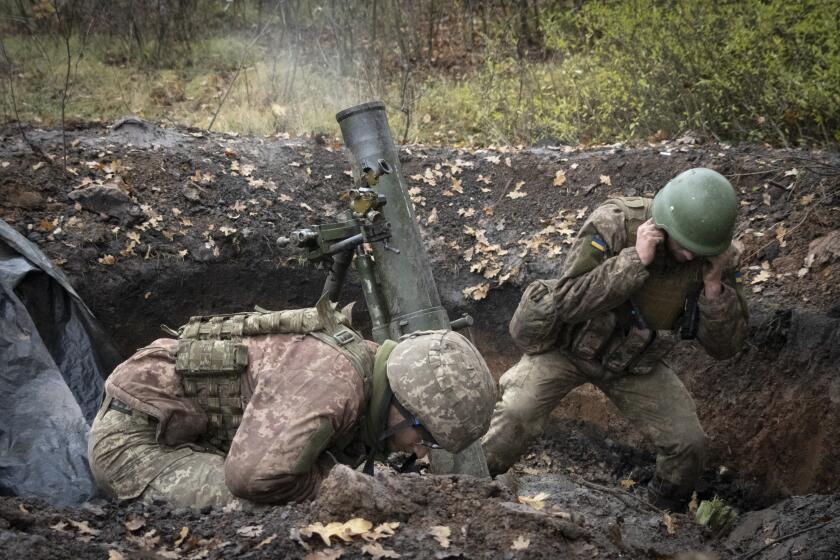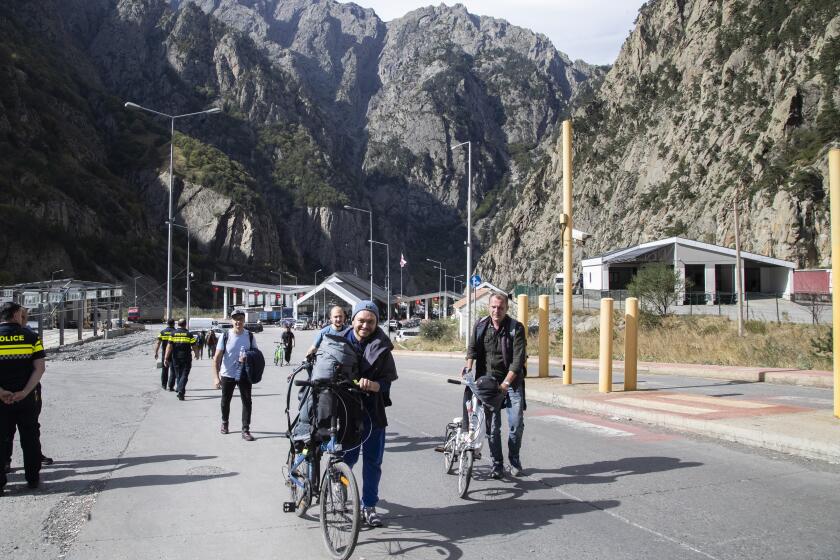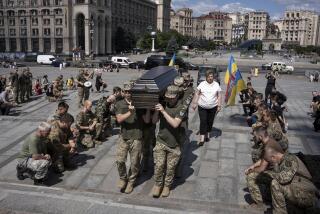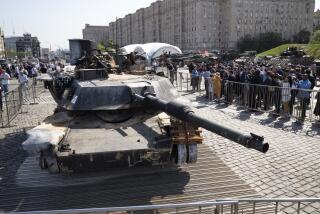Blackouts worsen in Ukraine; fighting rages on many fronts

- Share via
KYIV, Ukraine — Relentless Russian attacks on energy infrastructure prompted Ukrainian authorities on Friday to announce worsening blackouts around the country’s largest cities, with Kyiv’s mayor warning that the capital’s power grid is working in “emergency mode” with energy supplies down as much as 50% from prewar levels.
Meanwhile, the Russian president sought to dispel criticism of a chaotic call-up of 300,000 reservists for service in Ukraine by ordering his defense minister to make sure they’re properly trained and equipped for battle.
In the Kyiv region, as winter looms, the latest damage to utilities would mean outages of four or more hours a day, according to Ukrenergo, the state operator of Ukraine’s high-voltage transmission lines.
But Gov. Oleksiy Kuleba warned “more severe and longer shutdowns will be applied in the coming days.”
Kyiv Mayor Vitali Klitschko said the city’s power grid was operating in “emergency mode” and added he hoped Ukrenergo would find ways to address the shortage “in two to three weeks.”
The former boxing world champion also said new air defense equipment has been deployed in the Ukrainian capital to help defend against Russian drone and missile attacks on energy facilities.
In the Kharkiv region, home to Ukraine’s second-largest city of the same name, Gov. Oleg Syniehubov said daily one-hour power outages would begin Monday.
Russian forces are edging closer to a city in eastern Ukraine that they have tried to seize for months as their comrades suffer big losses elsewhere.
Officials across the country have urged people to conserve by reducing electricity consumption during peak hours and avoiding the use of high-voltage appliances.
Ukrainian President Volodymyr Zelensky said last week that 30% of Ukraine’s power stations had been destroyed since Russia launched the first wave of targeted infrastructure strikes on Oct. 10.
In Moscow, Russian President Vladimir Putin told Defense Minister Sergei Shoigu that the thousands of reservists who were recently called up need the right training and equipment so “people feel confident when they need to go to combat.”
Shoigu told Putin that 82,000 reservists had been deployed to Ukraine, while 218,000 others were still being trained. He said there were no immediate plans to round up more, but Putin’s mobilization order left the door open for a future military call-up.
In numbers comparable to the size of Putin’s 300,000-strong mobilization, Russian men are fleeing military call-up. Not everyone welcomes them.
Putin’s effort to beef up the number of troops along the 620-mile front line followed recent setbacks, including a Russian withdrawal from the Kkarkiv region. The mobilization, however, fueled scores of protests in Russia and prompted hundreds of thousands of men to flee the country.
Activists and reports by Russian media and the Associated Press said many of the draftees were inexperienced, were told to procure basic items such as medical kits and flak jackets themselves, and did not receive training before they were sent to fight. Some were killed within days of being called up.
Shoigu acknowledged that “problems with supplies existed in the initial stages,” but told Putin those have now been solved.
Putin ordered Shoigu to propose ways to reform the ground troops and other parts of the military based on their performance in Ukraine.
Meanwhile, Russian missile and artillery barrages pounded targets across Ukraine. Several towns across the Dnieper River from the Russian-occupied Zaporizhzhia Nuclear Power Plant were struck, the presidential office said. Shelling damaged dozens of residential buildings in Nikopol, and power was cut there and to thousands of families in neighboring towns.
When Russian troops crossed from Belarus into Ukraine in late February, pressing toward Kyiv, they were ordered to block and destroy ‘nationalist resistance.’
A Russian S-300 air defense missile destroyed a three-story office building and damaged a new residential building nearby, said Mykolaiv regional governor Vitalii Kim. Russian forces have frequently used converted S-300 missiles to strike ground targets in Ukraine.
Moscow also pressed its ground advance on the cities of Bakhmut and Avdiikva after a string of setbacks in the east. The fighting had turned the entire Donetsk region into “a zone of active hostilities,” according to Gov. Pavlo Kyrylenko.
“Civilians who remain in the region live in constant fear without heating and electricity,” Kyrylenko said in televised remarks. “Their enemy is not only Russian cannons but also the cold.”
A Russian takeover of Bakhmut, which has remained in Ukrainian hands throughout the war, would open the way for the Kremlin to push on to other Ukrainian strongholds in the heavily contested Donetsk region. A reinvigorated eastern offensive could also potentially stall or derail Ukraine’s push to recapture the southern city of Kherson, a gateway to Crimea, which Russia annexed from Ukraine in 2014.
Ukrainian forces pressing a counteroffensive in the south have zeroed in on Kherson, a strategic city seized by Russia in the early days of the war.
Last month, Putin also illegally annexed the Donetsk, Kherson, Luhansk and Zaporizhzhia regions. Much of the fighting since then has appeared geared toward consolidating Moscow’s control over that territory, which Putin has put under martial law.
Luhansk Gov. Serhiy Haidai reported Friday that Russian soldiers had retreated from some areas; Moscow had claimed Luhansk’s complete capture in July.
“The Russians practically destroyed some villages after they started to retreat,” Haidai said. “There are a lot of freshly mobilized Russians in the Luhansk region, but they are dying in droves.” His claim could not be independently verified.
In the Zaporizhzhia region, Kremlin-appointed officials urged residents not to switch to daylight saving time along with Kyiv and the rest of the country. Russia switched to permanent winter time in 2014.
“We live in the Russian Federation, and our city lives by Moscow time,” said Alexander Volga, the Russian-installed mayor of Enerhodar, where Europe’s largest nuclear power plant is located.
Meanwhile, inspectors from the International Atomic Energy Agency planned to visit two locations where Russia alleged, without citing evidence, that Ukraine was building radioactive “dirty bombs.” IAEA Director General Rafael Grossi said inspectors are being dispatched after a written request from the Ukrainian government.
Moscow has repeatedly made the unfounded claim that Ukraine is preparing to detonate a device that spreads radioactive waste on its own territory while trying to blame Russia. Western officials have dismissed the claim as misinformation possibly designed as a pretext for Russia’s own military escalation.
More to Read
Sign up for Essential California
The most important California stories and recommendations in your inbox every morning.
You may occasionally receive promotional content from the Los Angeles Times.

















